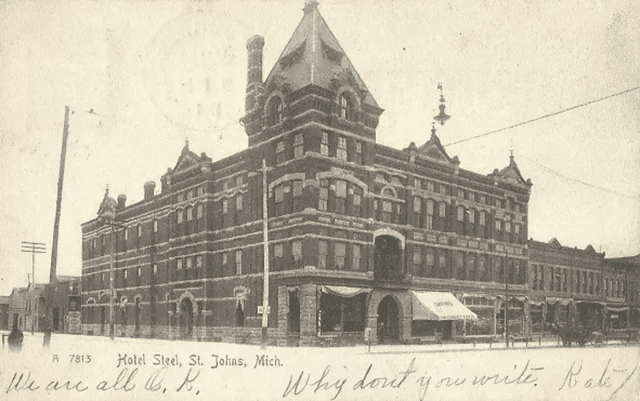The Steel Hotel in Saint Johns, Michigan A Touch of the Past Reviving the Present
Tucked away in a quiet corner of Saint Johns, a small town in Michigan, stands the historic Steel Hotel a proud relic of an era when American architecture was bold, expressive, and deeply rooted in craftsmanship. Built back in 1886, this building isn’t just a structure made of bricks and stone; it’s a symbol of a time when Gothic Revival and imperial architectural styles shaped the identity of towns across the United States.
Designed by the talented architect George Smith, the hotel played a central role in the city’s social and economic life from the moment its doors first opened. Today, although it no longer functions as a hotel in its entirety, its legacy lives on through the walls and stones that still whisper stories of a bygone age.

An Architectural Style That Speaks Volumes
What immediately catches the eye is the building’s elegant yet sturdy appearance. With five floors, the hotel features a red-brick façade, arched windows, and decorative limestone accents. Some of the original stained glass windows still hint at the grandeur of its early days.
This structure is a fine example of late Gothic Revival architecture with subtle imperial touches a style that was both ornamental and functional, reflecting the ambitions of 19th-century American urban design.
| Design Element | Key Features |
|---|---|
| Architectural Style | Late Gothic Revival with Imperial touches |
| Main Materials | Red brick – Limestone – Stained glass |
| Number of Floors | 5 |
| Year Built | 1886 |

A Hub for Culture, Society, and Mystery
The Steel Hotel was more than just a place for travelers to rest. It was a gathering spot for the community hosting political figures, business leaders, and cultural events. During the Prohibition Era of the 1930s, the hotel took on a different kind of fame, becoming a discreet meeting point for locals looking for a quiet escape adding a layer of intrigue to its already rich history.
Preserving a Piece of History
Over the years, the building naturally aged, but its historical value never faded. In 1974, it was officially listed on the National Register of Historic Places a recognition of its architectural and cultural significance.
Today, part of the building is used as residential space, while ongoing efforts aim to restore other sections, potentially bringing the hotel back to life as a boutique inn or cultural center.
ArchUp continues to track transformations in the construction industry, spotlighting projects that embrace innovation and reshape the urban landscape. The Museum of the Future is proof that when imagination meets dedication, the impossible becomes reality.







